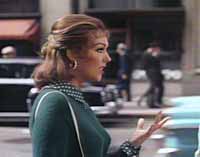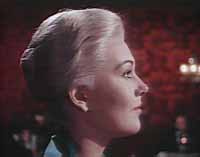










|

 Judy's silhouette as seen by Scottie.
|
 The second reason for all the profiles? Hitchcock's Vertigo has repeatedly been claimed for psychoanalysis, but the film is very sophisticated in exploiting our most basic cognitive skills, particularly the ability to remember and recognize a familiar face (profile). While psychoanalysis has its unconscious, cognitive science holds that many types of cognition can operate extra-consciously. Having learned to drive, one can carry out this complex task while consciously attending to tonight's dinner, and with little attention to the task at hand. Considering the lack of conscious attention devoted to driving it is a wonder (a marvel of extra-conscious cognition) that roads aren't choked with debris. What does this have to do with Vertigo? Facial recognition is typically an extra-conscious, "habituated" process that functions both in reality and in film. The second reason for all the profiles? Hitchcock's Vertigo has repeatedly been claimed for psychoanalysis, but the film is very sophisticated in exploiting our most basic cognitive skills, particularly the ability to remember and recognize a familiar face (profile). While psychoanalysis has its unconscious, cognitive science holds that many types of cognition can operate extra-consciously. Having learned to drive, one can carry out this complex task while consciously attending to tonight's dinner, and with little attention to the task at hand. Considering the lack of conscious attention devoted to driving it is a wonder (a marvel of extra-conscious cognition) that roads aren't choked with debris. What does this have to do with Vertigo? Facial recognition is typically an extra-conscious, "habituated" process that functions both in reality and in film.
|

And the transformation is complete: Judy becomes Madeleine.
|
 Vertigo exploits this skill by habituating viewers (through Scottie's detective work and his obsession) to a Madeleine Ideal, which is then unconventionally destroyed, only to be reborn in front of our eyes in the guise of Judy. Vertigo exploits this skill by habituating viewers (through Scottie's detective work and his obsession) to a Madeleine Ideal, which is then unconventionally destroyed, only to be reborn in front of our eyes in the guise of Judy.
How do we know that there is such a thing as facial recognition? Besides the obvious experiences available to anyone through introspection, evidence from neurology is compelling. Indeed, strokes and brain lesions sometimes destroy a person's ability to recognize faces, including loved ones, even as other cognitive abilities continue to function. The title of an Oliver Sack's book--The Man Who Mistook His Wife For a Hat--refers to an actual event that occurred to a patient of Sack's who suffered from this prosopagnosia. Most of us, fortunately, just take facial, or voice, or language recognition for granted.
|

Judy as Scottie first sees her on the street.
|
 When Scottie sees Judy on the street for the first time the viewer has been set up to share Scottie's cognitive dissonance (she looks/but doesn't look like Madeleine). The curious sensations that occur during the last half of the film during Madeleine's rebirth might rest in Vertigo's careful manipulation of this cognitive dissonance as we compare the Madeleine Ideal with all manner of variations: Judy from Kansas; Midge; Midge in her self portrait as Carlotta; the female doubles of Madeline seen at Ernie's, on the street, as dress models; Carlotta in her painting; Carlotta apparently alive in Scottie's dream. When Scottie sees Judy on the street for the first time the viewer has been set up to share Scottie's cognitive dissonance (she looks/but doesn't look like Madeleine). The curious sensations that occur during the last half of the film during Madeleine's rebirth might rest in Vertigo's careful manipulation of this cognitive dissonance as we compare the Madeleine Ideal with all manner of variations: Judy from Kansas; Midge; Midge in her self portrait as Carlotta; the female doubles of Madeline seen at Ernie's, on the street, as dress models; Carlotta in her painting; Carlotta apparently alive in Scottie's dream.
Robert Baird teaches film and serves as a Multimedia Consultant for
the University of Illinois English Department. He is currently working on a book
entitled How Movies Scare Us: A Cognitive Poetics of the Threat Scene.
He thanks Craig Fischer for important conceptual and stylistic help with this article.
Related article: Love, Desire, the Image, and the Grave.
Photo credits: Universal/MCA Home Video
|
|


 The repeated use of the profiles accomplishes at least two significant effects: (1) they link Scottie's (Jimmy Stewart's) obsession with Madeleine to the western aesthetic conventions for representing feminine beauty. That is, Hitchcock transforms Novak/Madeleine into a work of art: statuesque, reserved, posing, in profile--"those beautiful phony trances" Scottie angrily cries when he discovers the artifice.
The repeated use of the profiles accomplishes at least two significant effects: (1) they link Scottie's (Jimmy Stewart's) obsession with Madeleine to the western aesthetic conventions for representing feminine beauty. That is, Hitchcock transforms Novak/Madeleine into a work of art: statuesque, reserved, posing, in profile--"those beautiful phony trances" Scottie angrily cries when he discovers the artifice.
 Of course this is all motivated narratively. Gavin Elster and Judy knew how to go about manufacturing a beautiful, mysterious woman for their plan of seducing Scottie because they were familiar with the conventions for representing feminine beauty, whether from high art, fashion, or Hollywood itself! And so, for the first half of the film we look at Madeleine through Scottie, who is always looking, first as detective then as lover.
Of course this is all motivated narratively. Gavin Elster and Judy knew how to go about manufacturing a beautiful, mysterious woman for their plan of seducing Scottie because they were familiar with the conventions for representing feminine beauty, whether from high art, fashion, or Hollywood itself! And so, for the first half of the film we look at Madeleine through Scottie, who is always looking, first as detective then as lover.


 The second reason for all the profiles? Hitchcock's Vertigo has repeatedly been claimed for psychoanalysis, but the film is very sophisticated in exploiting our most basic cognitive skills, particularly the ability to remember and recognize a familiar face (profile). While psychoanalysis has its unconscious, cognitive science holds that many types of cognition can operate extra-consciously. Having learned to drive, one can carry out this complex task while consciously attending to tonight's dinner, and with little attention to the task at hand. Considering the lack of conscious attention devoted to driving it is a wonder (a marvel of extra-conscious cognition) that roads aren't choked with debris. What does this have to do with Vertigo? Facial recognition is typically an extra-conscious, "habituated" process that functions both in reality and in film.
The second reason for all the profiles? Hitchcock's Vertigo has repeatedly been claimed for psychoanalysis, but the film is very sophisticated in exploiting our most basic cognitive skills, particularly the ability to remember and recognize a familiar face (profile). While psychoanalysis has its unconscious, cognitive science holds that many types of cognition can operate extra-consciously. Having learned to drive, one can carry out this complex task while consciously attending to tonight's dinner, and with little attention to the task at hand. Considering the lack of conscious attention devoted to driving it is a wonder (a marvel of extra-conscious cognition) that roads aren't choked with debris. What does this have to do with Vertigo? Facial recognition is typically an extra-conscious, "habituated" process that functions both in reality and in film.
 Vertigo exploits this skill by habituating viewers (through Scottie's detective work and his obsession) to a Madeleine Ideal, which is then unconventionally destroyed, only to be reborn in front of our eyes in the guise of Judy.
Vertigo exploits this skill by habituating viewers (through Scottie's detective work and his obsession) to a Madeleine Ideal, which is then unconventionally destroyed, only to be reborn in front of our eyes in the guise of Judy.
 When Scottie sees Judy on the street for the first time the viewer has been set up to share Scottie's cognitive dissonance (she looks/but doesn't look like Madeleine). The curious sensations that occur during the last half of the film during Madeleine's rebirth might rest in Vertigo's careful manipulation of this cognitive dissonance as we compare the Madeleine Ideal with all manner of variations: Judy from Kansas; Midge; Midge in her self portrait as Carlotta; the female doubles of Madeline seen at Ernie's, on the street, as dress models; Carlotta in her painting; Carlotta apparently alive in Scottie's dream.
When Scottie sees Judy on the street for the first time the viewer has been set up to share Scottie's cognitive dissonance (she looks/but doesn't look like Madeleine). The curious sensations that occur during the last half of the film during Madeleine's rebirth might rest in Vertigo's careful manipulation of this cognitive dissonance as we compare the Madeleine Ideal with all manner of variations: Judy from Kansas; Midge; Midge in her self portrait as Carlotta; the female doubles of Madeline seen at Ernie's, on the street, as dress models; Carlotta in her painting; Carlotta apparently alive in Scottie's dream.